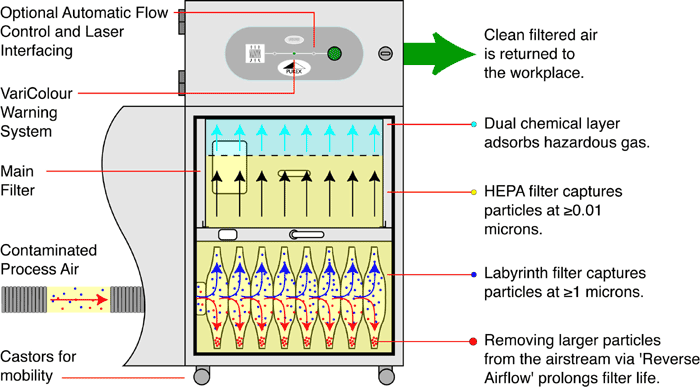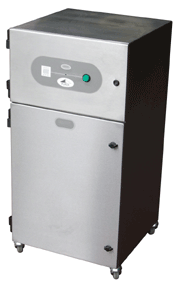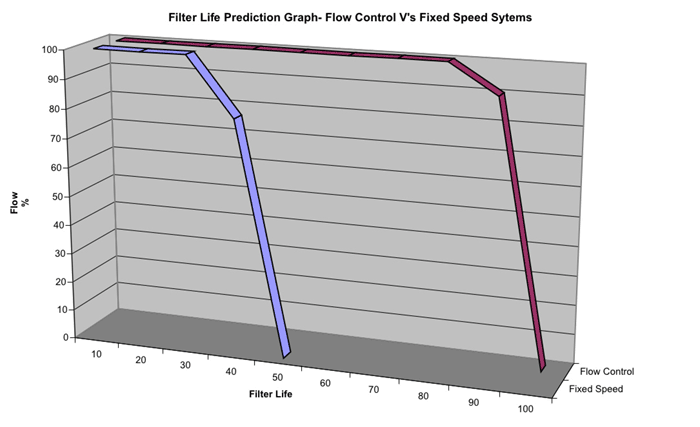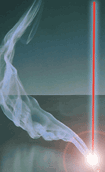Introduction
Marking (or coding) lasers are used in a huge variety of applications to add traceable information such as use by dates and batch codes to packaging and products. Examples of these applications are marking bottles in a beverage plant, batch coding of medical devices, marking PCBs and components in the electronics industry, adding data to cables and pipes and many others where permanent information needs to be added to a product. Engraving lasers are commonly used in the gift industry to mark logos and information onto pens, coasters etc. and can also be used to cut shapes in a variety of materials. Due to their increasing affordability and versatility, engraving lasers are also becoming more popular with school and college art and craft departments.
Both laser marking and laser engraving systems burn away layers of material to cut or mark a material. This process generates a fume that contains small toxic particles and gases that are hazardous to health. Some examples are Benzene and Toluene released from certain plastics and Chromium and Nickel given off by some metals. Virtually all materials (when processed) will emit some fumes that are hazardous to health; even cardboard and paper labels can produce respirable dust and formaldehyde.|
Worldwide health and safety legislation deems it vital that these fumes are dealt with effectively as they can cause serious long-term medical conditions such as occupational asthma and leave employers open to expensive compensation claims by employees.
The particulate generated by laser processing can also coat or even damage expensive laser optics and cause beam attenuation leading to blurred or incomplete marks. If this dust is not removed efficiently it can also contaminate products that may need to be rejected and it can coat the laser enclosure and associated machinery meaning increased downtime for cleaning. A failure in fume extraction is usually a ‘line stopper’. In high volume production (e.g. PCBs, pharmaceuticals, food/beverage packaging) improperly coded products and the resulting downtime due to fume extraction failure can cost thousands.
Selling or buying a laser.
It is now widely accepted that some form of fume extractor will be required when purchasing a laser. On the one hand the customer has to consider their budget and performance requirements and on the other hand the laser sales person wants to clinch the sale of the laser. There are two ways to go in this situation. (1) The customer can purchase both the laser and a fume extractor from the Laser OEM or (2) they can only purchase the laser and source an extractor from elsewhere. Option (1) is the better method for several reasons.
The laser sales person may think that quoting a laser with an extractor will put the customer off because of the additional cost, but this is usually not the case as the customer knows they will have to buy an extractor from somewhere anyway. By not quoting for an extractor the sales person is losing extra potential revenue and the customer may end up with an unsuitable extractor from another source. The unsuitable extractor may then cause problems with the laser process, for example causing the laser to produce blurred marks. This can leave the customer unhappy and potentially wondering if it is the laser that is at fault.
It is much better then to quote a whole package to the customer who can benefit from the laser manufacturer’s knowledge of specifying the correct extractor. The laser OEM also gets the long-term benefit of supplying the customer with replacement filters and the customer gets a problem free laser process. We (Purex) have even seen the quality of the fume extractor be the deciding factor for the customer when comparing two laser brands.
Budgets are of course a consideration for the customer, however, very low cost fume extractors available on the market can trade performance, filter life and even safety for cost. Simple fans which vent to the outside may seem an economical solution at first but they have significant drawbacks, i ) holes need to be cut in walls / ceilings. ii ) planning permission may be required. iii ) environmental legislation comes into play iiii ) bulky, fixed pipework is required and iv ) what happens if the laser moves? The fan, holes, pipework, fixings etc need to be reinstalled in the new position and the old ones filled and sealed which will be expensive. Also an external venting point may not be available; for example in a shopping mall or school.
A cheap extractor may also cost much more in terms of replacement filters. Worse still if the extractor is inadequate then the health and safety of the operator will be at risk.
What to consider
What does a budget conscious customer and a laser manufacturer need to both be happy with the laser/extractor package? New lasers coming onto the market are less expensive, more compact and are sold into new areas such as schools, offices and shops. So a good extractor needs to be compact, affordable, quiet, mobile and deliver excellent extraction rates and filter life. 
The new Laserex Alpha from Purex has been designed along these key principles. The basic machine offers the customer a very affordable solution and comes in two models, a 200m3/hr and a 400m3/hr version depending on the size of the laser. Both models have a small footprint of only 465mm2 so they take up minimal space in areas where this is a consideration. All units are mounted on lockable castors to make the machines highly mobile so if the laser moves the user can simply push the extractor after it.
To reduce noise levels the machines employ Whisper Stream technology, a unique powerful blower and silencing system that delivers excellent performance, maximum reliability and whisper quiet operation at less than 45dBA – essential in places such as schools or shops.

It is also of paramount importance that the health and safety of employees is protected. To ensure this the Alpha features the VariColour warning system. This system constantly monitors the condition of the filters and reports automatically via a single variable colour LED.
• Green shows the filter is clean.
• Amber warns the operator that a replacement filter will be required soon.
• Red (along with an audible alarm) tells the operator when to replace the filter.
Filters
A major benefit of buying a laser is that they have few consumables when compared with other methods of marking such as inkjets. Therefore the last thing the customer wants is to have to buy lots of replacement filters for their fume extraction system. Several design features are employed in the Laserex Alpha to ensure filters have a long lifespan and therefore consumable costs are low for the customer.
The first of these is Reverse Airflow, a system pioneered by Purex in the electronics industry and now used in laser fume extraction. Large particles within laser fume will prematurely block a filter over time. To prevent this the speed of the air is slowed when entering the Alpha machine and the direction is changed from horizontal to vertical forcing larger particles out of the air stream in an action similar to a centrifuge. These particles are deposited in the base of the Labyrinth pre-filter thus prolonging its life.
The Labyrinth pre-filter is used to protect the main HEPA filter from premature blockage. It does this by removing particles from the airstream at ≥1 microns in size. This quick change, patented filter technology is not available from any other manufacturer and is designed to overcome inherent weaknesses in pleated paper and bag filter design. The filter’s unique shape, dust holding capacity and deep graded filter media means that more particles can be captured and therefore the main HEPA filter lasts that much longer.
The small, lightweight and robust construction of this filter means that storage and shipping costs are minimal compared with other larger and heavier pre-filters. Also, problematic materials that produce sticky particles can be handled safely and efficiently.
A reinforced, submicronic HEPA media is used in main filters to remove small hazardous particles from the airstream. Purex filters are proven in independent tests to capture 99.997% of particles at 0.3µm and 95% at 0.01µm in size. A high performance deep chemical layer in the filter then adsorbs toxic gas before clean air is returned to the workplace. All filters are easily accessed from the front of the machine and can be changed in seconds without having to move the machine and without using tools.
These design features ensure that filter changes are kept to a minimum therefore consumable costs for the customer are low. This is an attractive fact for the customer and a good selling point for the laser sales person. In many cases the savings made by reducing rejects and downtime caused by incorrectly specified fume extraction systems would pay many times over for a new Laserex Alpha.
Additional features.
As always the customer may require additional control of a fume extractor or they may not, depending on the individual application. The Laserex Alpha has the option to interface with the laser for better control and also to precisely control airflow and speed, increasing filter life and further reducing cost to the customer.
Upgrade pack-1 – Flow Control.
In their most basic form most fume extractors simply turn on or off without the option to raise or lower their extraction rate. This fixed speed method of operation is not as energy efficient as a variable speed drive and having too high an extraction rate can cause drag marks on the product during engraving.
Filters will last longer if the speed at which the particles pass through the filter media is controlled and maintained so the Alpha upgrade pack-1 includes a speed control system that allows the customer to set the airflow to the optimum level on site (particularly useful for engraving lasers). To prevent the extraction rate falling as the filter becomes blocked this upgrade pack also includes a fully automatic “Closed Loop Flow Control” system. This system maintains the airflow at precisely the level set by the operator by automatically adjusting the motor speed. The cost of the upgrade pack is quickly offset by the extension of filter life and increased control.

Closed Loop Flow Control Ensures:
•
Filter life is maximised.
•
Consumable costs are lowered.
•
No manual intervention is required to maintain extraction rate.
•
Personnel are constantly protected.
•
Airflow is constant throughout the life of the filter.
Upgrade pack-2 – Laser Interfacing:
Additional safety functions and controls are available by simply interfacing the Laserex Alpha with the laser using upgrade pack-2. Interfacing with the laser provides a closed loop, automatic solution where operator intervention is kept to an absolute minimum.
For added safety, the extraction is automatically started when the laser is switched on. This prevents any damage to the laser optics or any hazardous fume entering the workplace. To ensure that all fumes are removed when the laser is switched off, the Alpha will continue to run for a short period before switching off.
If any alerts are generated by the extraction system then a signal is sent to the laser. This signal can either trigger an alert on the laser and associated alarm systems (e.g. a beacon) or it can shut the laser down.
Summary
Health and Safety legislation and the need to protect the product and laser optics make the need for a fume extraction system undeniable. By producing the Laserex Alpha at the right price, with such a good standard feature set and with affordable upgrade options Purex believe that they have catered for everyone’s requirements. The laser sales person increases their turnover and their customer gets the right solution at the right time and price.
For further information visit http://www.laserfume.com for your local office or call Purex on +44(0)1709 763000.
|








